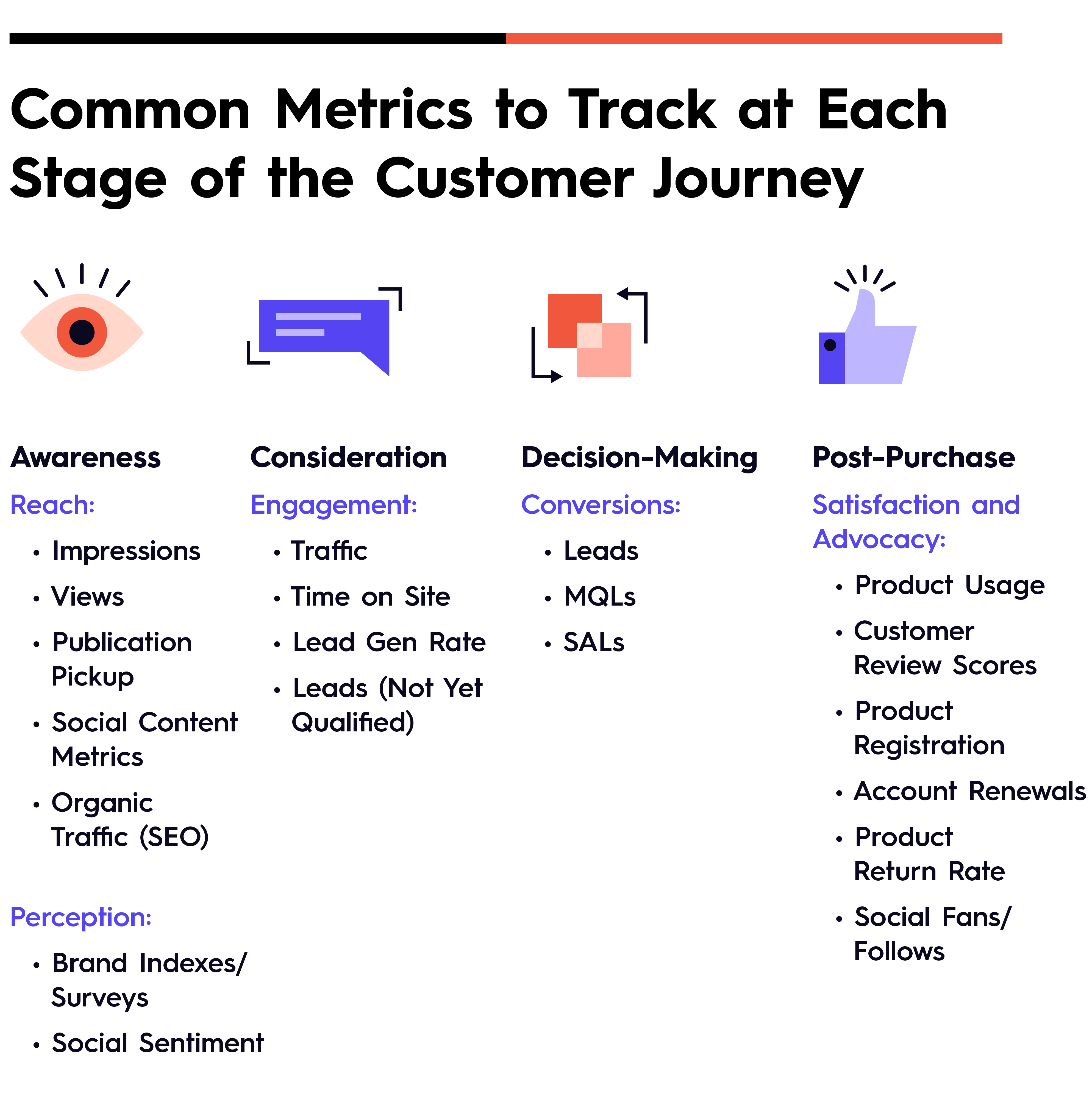There’s nothing more frustrating than sinking time, energy, budget, and resources into marketing that doesn’t move the needle. That’s why having a strong content strategy is crucial. And while there are many elements of a content strategy (e.g., your goals, content ideas, editorial calendar), the most important thing you need is a way to know if what you’re doing is actually working. This is why choosing the right content marketing metrics can make or break you.
Luckily, we’ve helped plenty of brands set up their marketing strategies, and we’ve tinkered with our own a ton (which has helped us increase our leads tremendously). What we’ve learned in that time is that choosing the right marketing metrics is a unique process for every brand, but there are a few simple steps you can take to do it the right way.

Why Do Content Marketing Metrics Matter?
In short, metrics are the key to working smarter and more effectively across the board.
- Metrics give you benchmarks. To track your success, you need to know where you’re starting and where you want to go. Data is the secret to understanding what’s working, what’s not, and how you need to tweak your content strategy to stay on the right track.
- Metrics help you justify creative decisions. Getting buy-in from your team, especially your more analytical or risk-averse stakeholders, can be a challenge. With data behind you, you can always defend your creative decisions. Note that this doesn’t always mean you need perfect justification for your decisions—you should always leave room for experimentation. But it’s important to know when you’re going out on a limb versus playing it safe so you can balance your risk-taking.
- Metrics help you demonstrate ROI. For every marketer, ROI is what it’s all about. Whether you need to demonstrate your success or justify more budget, having the numbers on hand will help you make your case. (BTW, if you need more budget, here are 5 ways to get it.)
So how do you go about getting those numbers, and how do you use them to shape a strong (but flexible) strategy? Let’s dive in.
1) Choose Your Goals
“Doing marketing” isn’t your job. Doing marketing that supports your business goals is your job. So when we talk about choosing content marketing metrics, the question is really, “What are you trying to achieve?”
It’s important to map your metrics to your objectives from the very start. That way you’ll know you’re always aligned. For example, a young, hip ecommerce store might focus on social engagement and sales, whereas a B2B software sales company will track product demos and subscriptions.
(BTW, if you don’t know your goals and have never actually completed a content strategy, here’s our easy step-by-step guide to do it.)
2) Identify the Metrics That Support Your Goals
There are a million options to choose from. If you track everything, you’ll drown in data. That’s why it’s smarter to narrow down your metrics for each stage of the buyer’s journey to only those that provide the most insight and value. Again, this will depend on your goals, business, unique product/service, etc.
As a rule of thumb, prioritize 2-3 that are directly aligned with your business goals, and use any others as contextual indicators. Just remember that those metrics should be:
- Relevant: They map to your goals.
- Accessible: You can actually track them.
To help you narrow it down, we’ve outlined the most common marketing metrics below (broken down by stage). That said, there is overlap. You may categorize these differently according to your specific needs.
Awareness
- Reach:
- Impressions
- Page Views
- Unique visitors
- Publication pickup
- Social content (followers, likes, subscribers)
- Email/newsletter (subscribers, unsubscribers, open rate, churn rate)
- Organic traffic (SEO)
- Perception:
- Brand indexes/surveys
- Social sentiment
Consideration
- Engagement:
- Site traffic
- Time on site
- Lead gen rate
- Bounce rate
- Return rate
- Pages per visit
- Comments
- Asset downloads (e-books, coupons, etc.)
Analysis
- Conversions:
- Leads
- Qualified leads
- MQLs
- SAL
Purchase
- Deals closed
- Upgrades
- Upsells
Loyalty
- Satisfaction and advocacy:
- Referrals
- Product usage
- Customer review scores
- Product registrations
- Account renewals
- Product return rate
- Testimonials
Once you narrow it down and get the OK from your team, you can put them to work.

3) Consider Your Formulas
After choosing your metrics, you may also want to take it a step further to extract even deeper meaning. Blending two metrics together will let you answer questions like:
- How much does a lead cost to acquire? (leads totals / campaign costs)
- What is the average lifetime value of a customer? (customer totals / average opportunity)
These can be incredibly valuable.
4) Ensure You Have Your Infrastructure Set Up
Depending on the marketing metrics you choose, make sure you have all tracking tools and analytics set up. Double and triple-check that they are working correctly.
5) Measure and Experiment
To improve your results, it’s important to test and experiment, iterate, then test again. So now is the time to craft your hypotheses to test your efforts.
What do you expect to happen, and why? A strategy is never foolproof; at the end of the day, your approach is the result of humans (with the support of robots, for now) taking best guesses as to how certain goals can be reached.
By taking a page from the scientific method and documenting your hypothesis, supporting data, and underlying assumptions, you’ll learn a great deal more once your strategy is executed in the market. You can’t expect to be right about everything, but a hypothesis will at least give you clarity about what went right, what went wrong, and how you can improve over time.
You may also find that, as your strategy changes, there are more relevant metrics to track. This is all part of the game. In fact, we recommend revisiting your metrics every 6 months or so to make sure they’re still working for you.
That said, here are a few things to do to get the most from your metrics going forward.
- Set up regular reporting. Don’t let your data die in spreadsheets. Create regular reports to dive into the data, extract interesting insights, and share with your team. Monthly reports are a good way to start. Many teams benefit from more informal weekly reporting check-ins as well, but keep your big picture in mind.
- Identify weaknesses, and brainstorm solutions. It’s OK if you’re struggling in one area. (Again, the whole point is to identify what does and doesn’t work.) With regular reporting, you can come up with better tactics or suggest new things.
- Play to strengths, and test hypotheses for why certain things are working. In the same way that hypotheses are valuable for large, strategic-level decisions, they’re also a smart way to add precision to your conclusions. If you think a certain Facebook ad was effective because you used the color blue, test it out in your next campaign on a different topic.
- Compare the efficacy of your marketing tactics. Consider how some tactics may help you in other areas—and what might be hurting you. For example, what’s your ROI for paid social versus event attendance or sponsorship? Be open to the idea that it’s not the channel that’s not working but how you’re using it.
- Engage in conversations about rates vs quantities. A low cost per lead might not last forever for a certain tactic. Keep pushing the limitations of your conclusions by investing more in what’s working and watching for diminishing returns. The results might give you an idea of your overall market size, a convenient business-intelligence byproduct of content marketing. Of course, maybe this is simply the point at which your message/campaign has run its course.
- Look for opportunities to invest more. If you’re seeing major progress in one area, consider doubling down. Again, one of the biggest advantage of reporting (and a content strategy in general) is the ability to see your entire content ecosystem and make better economic choices. The more success you have, the more effective your tactics. These tactics may be translated across your strategy.

Remember: Marketing Is Ever-Evolving
No matter what, stay persistent and keep educating yourself. For more tips on creating more successful content marketing…
- Find out why content campaigns can help you save time, money, and resources.
- Use these 100+ content marketing tools and resources to make better content.
- Check out the 10 content strategy lessons we learned the hard way to avoid making our same mistakes.
- Try these 5 tips to improve your ROI.
And if you get stuck, find out how a content agency can help you figure it out, or hit us up. We’d love to help you untangle your strategy.





